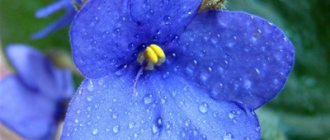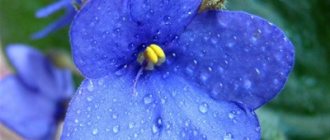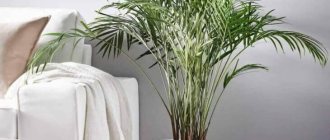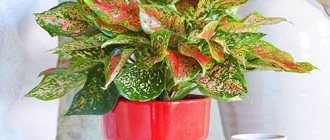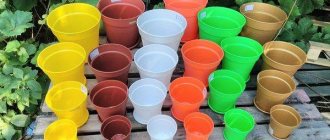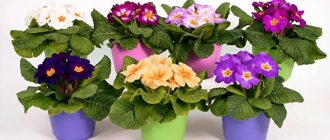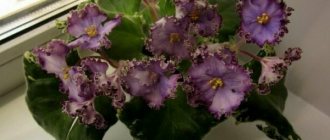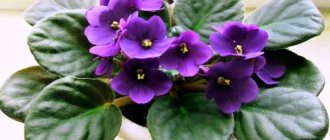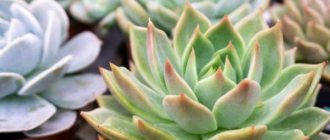Most indoor plant lovers place their green “pets” on the windowsill. If you prefer violets, then the window sill is precisely the most unfavorable place for growing this type of flower. In summer, direct sunlight can leave burns on the leaves of Saintpaulia. In winter, they may be exposed to hot, dry air generated by radiators. Another threat to Saintpaulias is the cold, which inevitably penetrates even through the most insulated window.
Favorable conditions
When choosing a good place to grow Saintpaulia, the best solution is shelves or special racks with lighting. You can even use a regular cabinet. All you need is to provide your favorite indoor plants with proper lighting , which will allow them to achieve the highest degree of decorativeness. This is quite simple to do; you just need to fix the lamps above the flowers at a distance of at least 20 centimeters. Thus, the optimal distance between racks or shelves should be at least 55 centimeters.
The plants themselves should be positioned so that the outer leaves of neighboring Saintpaulias do not touch. Moreover, the number of lamps directly depends on the depth of the shelf and its size. Florists recommend installing shelves whose depth will be approximately 50 centimeters. Another important condition is the width of the shelves for growing Saintpaulias, thanks to which it will be convenient for the owner of this type of indoor flowers to turn the pots on different sides to the light to ensure full photosynthesis.
It is worth considering the features of the lamps you will use. As a rule, a strong flow of light is concentrated in the middle of the lamp, and at its edges it is weaker.
For this reason, plants with dark green leaves should be placed closer to the center of the rack, as they absorb more light than plants with pale green foliage.
Use of stands and racks
If there were violets, we would decide how to place them. Even on 2-3 window sills. This is the opinion of most flower growers. This is both convenient for violets and very beautiful.
The main thing is to create comfortable conditions. And not just to set up pots. You can buy them ready-made, or order something individually. And even make it yourself. From available materials:
- Stands. In case of severe frosts and cold window sills, you can temporarily install it in a warmer place;
- Shelves;
- Shelving. With installed lighting.
These devices are made from:
- Plastic;
- Glass;
- Metal;
- Tree.
Glass shelves.
Stands-ladders.
Hanging flowerpots.
Backlight Features
One of the most common problems that violet lovers have to face is the lack of sunlight. Lack of lighting can lead to the following consequences:
- growth slowdown;
- lack of flowering;
- poor development.
To avoid the above potential problems, it is necessary to resort to additional illumination of the plant. LED strips are perfect for this function. It is recommended to choose a tape whose color spectrum will be cool shades, and the power will not exceed 25 watts per 1 meter.
It is necessary to resort to LEDs on cloudy days or when the sun does not shine in the direction where the flowers are located.
Consider also the fact that for the rapid development of violets, up to 14 hours of daylight are needed. The LED should be turned on several hours before sunset. This feature allows you to use additional light if your plants are located on a window sill. This type of lighting will not cause discomfort to the eyes and will create comfort in the home.
Another type of lamp that could serve as additional lighting is a fluorescent lamp. If your plants are located not on the windowsill, but on a shelf, then just such a lamp will be convenient to use. The strength of such a lamp is its ability to evenly distribute light over a fairly large radius, which other types of lamps cannot boast of. As a rule, fluorescent lamps are placed above the flowers at a short distance. Most often, most people choose this option.
And yet, experts recommend using LED strips at home.
Ideal lighting for violets
Violets need illumination, which is measured in lux. In old Soviet violet books they write that the ideal illumination for violets is 2500 lux (not to be confused with the luminous flux, which is measured in lumens and which is sometimes indicated in the characteristics of LED strips).
2500 lux is very bright illumination, which is 5-10 times more than what we can see in our apartments. Favorite violets 2500 lux are:
- much more than 50 lux in a living room
- and more than 80 lux in the entrance/toilet
- and more than 320-500 lux in the office
- and even more than 1000 lux on a cloudy day outside
- and only slightly less than 4000 lux at noon on the street in December-January
Lumens and Luxes
Often, beginning violet growers are guided by the lighting flux values in lumens, which are indicated on LED strips.
1. Luxes and lumens are in no way related to each other, although their first letters are the same:
- Lumens are the luminous flux that the tape produces.
- Lux is the illumination of the sockets, i.e. the number of light photons that fall on the leaves of our violets and what the violets actually feed on.
2. The lumens indicated for the LED strip are an ideal mythical figure, which in reality is much less:
- on Chinese tapes they can write any desired value of luminous flux in lumens and will not charge much
- when the tape is powered by a low-power power supply, the luminous flux will be several times less
- when powering a tape more than 5 meters long, at the far ends of the tape the luminous flux will be several times less
- for tape with moisture protection, they can write the luminous flux in lumens, which is emitted by LEDs. But “forget” to indicate that the transparent plastic protection of the tape will eat up half of this light flux.
Therefore, when choosing a tape, do not count the lumens too much. Violets do not need a luminous flux of 2500 lumens emitted from the tape, but an illumination of 2500 lux incident on them.
How to measure?
Illumination in lux is measured by a device called a lux meter. This device is sold separately (from 1000 rubles in Russian online stores, from 700 rubles on Ebay.com). It is also built into individual photo exposure meters that professional photographers have. Electricians and lighting advertisers may also have lux meters.
Ask your friends, probably someone has a lux meter that you can borrow for measurements for one evening.
A fly in the ointment, or completing an experiment with LEDs.
So, six months have passed since the installation of the rack with LED lighting. We can summarize. And in my case they are disappointing. Violets suffer monstrously from lack of light. Thanks to this rack, I almost threw out my entire collection (thank you, it got warmer and some of the violets moved to the windows). No matter what I did - I increased and decreased the daylight hours, raised and lowered the sockets, nothing helped! All my rosettes stretched out wildly, turned pale and began to dangle in the pots, like... um... Milky Way in an ice hole. And in order not to be unfounded, I’ll show you photos
Watering and fertilizers
You need to spray the violet carefully, using small portions of water and trying not to get it on the flowers. The ideal watering for violets is from a tray. But if you pour water directly into the pot, try to pour it in a thin stream, not to get it on the leaves or in the center of the rosette - this will cause the flowers to rot and die.
It is recommended to use fertilizers no more than once a month. Too much fertilizing affects the leaves - they turn yellow and fall off.
Reminder for a newbie!
Uzambara (Uzumbar) violet is a plant of the Gesneriaceae family, growing in the natural environment of tropical and subtropical regions of Asia, Africa, Eastern Australia, South America and the Indian Ocean islands.
Saintpaulia is a plant named after the Saint-Paul father and son, who brought a plant unknown to Europeans from the Uzambara district (modern Tanzania) in the 19th century, presented for the first time at the international flower exhibition in Ghent in 1893.
Indoor violet has been one of the most popular plants in indoor floriculture since 1927. By 1949, more than 100 varieties had been bred, and today their number exceeds several thousand.
Rooting
- possibly in water, in substrate, moss.
Priming
- purchased soil or a mixture of leaf, coniferous, turf and peat soil in a ratio of 3:1:2:1 with the addition of raising agents (perlite, vermiculite, river sand, crushed sphagnum moss.
Lighting - it is best to place flower pots on western or eastern windows. To ensure that the plant is evenly illuminated from all sides, the pots are periodically rotated. In winter, when daylight hours decrease, you can use artificial lighting - fluorescent lamps.
Caring is a real art and serious painstaking work at the same time, including watering, fertilizing, and creating a favorable humid climate. Water Saintpaulias as the soil dries. The soil must be moistened regularly, but excess moisture should not stagnate in the roots. When watering, you must ensure that water does not get on the leaves. You cannot water the Uzambara violet with cold water. Fertilizing is done with complex mineral fertilizer once every two weeks. Saintpaulia reacts negatively to a lack of nitrogen in the soil. Optimal air humidity is approximately 50%, temperature is 20-22 ° C, without sudden fluctuations and drafts. The leaves of the plant should not touch the window glass. Removal of faded flowers and damaged leaves is carried out regularly.
Reproduction - planting a leaf cutting, part of a leaf, or a daughter rosette. The most popular method is rooting leaf cuttings. The formation of roots and the development of children lasts 4-8 weeks.
Pests are one of the gardener's problems. There are many different types of pests and it is very difficult to classify them. Among Saintpaulia pests, several groups can be distinguished: mites (spider mites, flat mites, transparent mites, etc.), insects (aphids, thrips, springtails, poduras, scale insects, whiteflies, scale insects, etc.), worms (nematodes).
Diseases - distinguish between infectious (gray rot, powdery mildew) and non-infectious diseases (rotting of the stem and root, wilting of the lower leaves, yellowing, leaf spotting, incomplete opening and premature drying, falling of flowers) of plants. The causative agents of infectious diseases are bacteria, fungi, and viruses. To prevent infectious diseases, you should strictly observe the regimes of watering, temperature, humidity, and lighting. Non-communicable diseases usually arise due to poor agricultural practices. They may appear in one instance and not spread to others.
Many people like to grow home decorative plants, but not everyone has space on windowsills and near windows so that the flowers can receive daylight.
Here we will discuss such a topic as lighting for violets: which lamps are best to use, how long to illuminate these delicate and very sensitive flowers. Saintpaulia is capricious, and if it is not provided with the proper conditions for existence, then it will refuse to grow and delight you with its amazingly beautiful flowers.
Selecting LED strip
Additional characteristics of LED strips
LED strips are available in different designs:
- with warm white light
- with moisture protection
- colored
- 30 LEDs per 1 linear meter
- …
Each of these additional characteristics reduces the luminous flux emitted by the tape. When purchasing an LED strip, make sure you get the following strip:
- cold (bluish) white light
- it does not have a plastic wrap to protect it from moisture
- the LEDs are located at a distance of 1.6 cm (this will give the required 60 LEDs per 1 meter).
All subsequent calculations were made specifically for this set of characteristics of the LED strip.
It is best to buy LED strips in specialized stores with a large assortment. The sellers there will understand your clarifying questions about LED strips. In a conversation, never list to the seller the additional characteristics of the tape that you need. Ask questions that have multiple answers:
- what shade of white is this tape?
- Is this tape waterproof or not?
- …
Then:
- the seller will not be able to assent to you “yes, yes, this is a tape with exactly these parameters”
- it will be immediately clear whether he understands at all that the white LED strip has 2 different shades, depending on which its brightness changes by 2 times. Or what is the difference between waterproof tapes and non-waterproof ones.
Red-blue LED strips
In 2015, Osram-style LED strips appeared on the market, with red and blue LEDs interspersed:
Red-blue ribbons are produced in different proportions of red/blue:
- 4:1 (for 4 red LEDs there is 1 blue)
- 5:1
- 7:1
- 8:1
- 10:1
The combination of red with a hint of blue looks like pink light in the style of Osram lamps.
Manufacturers position such tapes for use in greenhouses and greenhouses. Red light is considered good for flowering of mature plants, blue light is good for leaf growth.
Ban on the use of red-blue LED strips
It is strictly not recommended to use ready-made red-blue LED strips to illuminate violets:
1. Red-blue tapes designed for greenhouses and greenhouses are made in a moisture-proof design, filled with waterproof plastic, which eats up half of the light passing through it. Violet growers who bought moisture-proof LED strips complain that the violets are holding their hands up due to lack of light.
2. In Osram lamps, a special gas was selected for the pink glow. With the same lamp power, the special gas produced light only in the required pink range. And LED red-blue strips use standard white LEDs with a cool tint, which the manufacturer paints alternately with red and blue paint. With equal power to a white LED strip, the red-blue strip shines approximately 4 times weaker.
3. Red-blue LED strips cannot be used to illuminate large greenhouses; they have too little power. They are designed for home greenhouses/greenhouses for customers who are far from lighting technology and who adore their indoor plants. Because of this, the price of a red-blue LED strip is 2 times higher than a white strip of the same power.
4. For violets, there is no need to filter the white lighting from the LED strip by painting them red and blue. Filtering white light into red-blue is the same as boiling meat for a dog or cat, which in nature eats meat perfectly without any cooking - predators have a digestive tract designed for raw meat.
Will violets themselves be able to produce red and blue from white? They can, and how! No one in nature illuminates plants with red-blue light. In the lower layer of the jungle there is no direct sunlight, but there is an abundance of green light with tiny remnants of red and blue. For centuries, violet leaves have been selecting from any falling green light the crumbs of the red-blue spectrum they need, and discarding the green part that no one needs. This is clearly indicated by the green light of the leaves, which look green because they reflect green light that the leaves do not need.
5. Violets do not have eyes; the lighting spectrum does not matter to them. You can shine the leaves with any color; the green color of the leaves will automatically let the red-blue color in and throw out the unnecessary green color. But violets, unlike violets, have eyes. For us, red and blue lighting is unnatural and interferes with the enjoyment of violet blooms.
Costs of red-blue LED strips
The 2x reduction in illumination of the red/blue LED strips due to waterproofing and the 4x reduction due to painting of the LEDs results in the need to purchase 8 times more red/blue strips to achieve the recommended illuminance of 2500 lux. Switching to lighting with ready-made red-blue LED strips significantly increases the cost of high-quality LED lighting:
- you need to buy red-blue tapes with 8 times more power
- Considering that red-blue tapes cost 2 times more than regular white tapes of the same power, in total you have to pay 16 times more for dull red-blue tapes
- the power supply is 8 times more expensive
- 8 times more electricity is consumed
- to dissipate such an amount of energy in the summer you have to buy and install an air conditioner
- The air conditioner spends 8 times more electricity to remove heat from the red and blue LED strips
- due to the fact that painted LEDs transmit only 25% of the light, the remaining 75% of the energy is retained by the paint on the LED and the LED heats it up well. The service life of the red-blue tape drops sharply, since LEDs, like any electronics, suffer greatly from heating.
In practice, violet makers do not have lux meters and they never try to increase the number of red and white ribbons to bring the illumination to 2500 lux. Therefore, instead of ordinary white LED strips, they simply buy an equal number of red-blue strips in full confidence that this is very good for violets. As a result, violets from red-blue waterproof LED strips are illuminated 8 times less and suffer terribly from underfeeding.
Sample Color LED Lighting
The article “My LED plant lighting” (in English) provides examples of colored LED lamps. The desired red-blue color in them is achieved by using one blue and one white LED for every 6 red LEDs. Take a closer look, you can even see by eye that the red and blue LEDs are obtained from colored LED bulbs, so the brightness of the red and especially blue LEDs is much less than that of unpainted white ones:
Still in doubt? On the left in the frame there is the exact same LED panel, but entirely made of blue LEDs. It is very dark to the eye, since it was also obtained by dyeing a white flask deep blue.
Colored LED panels cost 1.5-2 times more, but they shine 4-5 times weaker than similar LED panels with uncolored LEDs of the same power.
Homemade red and blue LED strip
For those who still continue to believe that violets benefit from red-blue lighting. Then make the red and blue ribbon yourself. To do this, buy red and blue tsapon-varnish (nail polish), 65 rubles, 30 gram jar in the Chip and Dip store. Applying tsaponlac to light bulbs is as easy as applying nail polish:
Paint a regular white LED strip with a brush in the proportion of 4 reds and one blue. Get:
- red and blue ribbon
- purchased at the price of white without a marketing markup of 50-100% for the goodness of the red and blue ribbon
- non-moisture-proof and not losing half the light on moisture protection.
A homemade red-blue LED strip will cost several times less than one that creates the same level of illumination. True, a shelf 50 cm deep will require 8-10 painted LED strips to create the level of illumination that 2 unpainted strips provide. Accordingly, for color lighting you will need:
- the power of power supplies is 4-5 times greater
- electricity costs are 4-5 times higher
- the air conditioner will have to be very powerful
- it will also consume a lot of extra electricity.
Painting dosage
Photographers have color filters, each filter indicates its multiplicity - how many times it reduces the amount of light:
- x1 is a one-time light filter, does not reduce light, it is a transparent light filter for filtering invisible ultraviolet light
- x2 - weak color filter, gives a slight color cast
- x4 is a regular color filter that turns white into a pronounced desired shade, this is exactly how red-blue LED strips are colored by their manufacturers.
When painting yourself, you can easily adjust the filter ratio with red and blue. The more layers of tsaponlak you put, the more pronounced the red or blue color will be and, accordingly, the dimmer the illumination from the painted LED strip will be.
The bravest ones can paint each LED immediately red-blue:
- apply 4 strokes of red to the LED
- After drying, add a touch of blue.
Or mix a jar of red tsapon-lac with 1/4 of a jar of blue tsapon-lac to obtain the desired concentration of red-blue tsapon-lac. It can be used to color all LEDs in a row. You can dose the required amount of tsapon-varnish with a syringe.
Experiment
If you still want to give your violets a nice red-blue lighting, then at least don’t paint the LEDs on all the shelves red-blue. Experiment with red and blue lighting on just one shelf. Violets will quickly show you that any color filter in front of the LED strip only reduces the lighting level. If you have a light meter, then immediately after painting you will see a 4-fold drop in illumination.
Although it is easier to conduct a thought experiment and understand that by its nature any filter does not convert one color to another, but cuts off unnecessary color and thereby reduces the amount of lighting. Blue or red paint on LEDs (from the manufacturer or our own, from Tsaponlak) transmits only 25% of the light flux of the desired color, and retains the remaining 75% of the unnecessary color in the spectrum and releases it on the LED in the form of heat:
For white LED strips painted by the manufacturer or with tsaponlak, you will pay in that the lighting on the shelf will decrease by 4 times. Despite the fact that natural filters of white daylight are already built into the surface of violet leaves, which:
- hold and absorb the blue and red light the leaves need (located at the edges of the light spectrum)
- throw back the green color unnecessary to the leaves (in the central part of the light spectrum).
Red-blue LED strips are a marketing ploy by manufacturers that lead to:
- to a large decrease in illumination of violets
- to multiple overpayments for red and blue ribbons
- to a multiple increase in electricity bills
- the need to use a particularly powerful air conditioner
- and in the absence of a lux meter - to great under-illumination of the violet collection.
Discussions:
- “Which is better, a white ribbon or a blue-red one?”
- “Using color film with a holographic pattern for shelving”
Main types of LED strips
LED strips differ in luminous flux, which is measured in lumens. We need illumination, it is measured in lux. There is a direct relationship between lumens and lux: 1 lux = luminous flux of 1 lumen falling per 1 square meter. The more lumens the tape produces, the higher the lux required by violets.
For each tape the following is indicated:
- luminous flux in lumens and required power per 1 meter of length (taken from technical specifications)
- the distance at which this tape provides the illumination required for violets of 2500 lux was measured with a lux meter:
So, the characteristics of the main types of LED strips:
- SMD3528 - 60 LEDs per meter - 300 Lumens, 4.8 W; 2 cm
- SMD3528 - 120 LEDs per meter - 600 Lumens 9.6W; 3 cm
- SMD5050 - 30 LEDs per meter - 360 Lumens 7.2W; 2.5 cm
- SMD5050 - 60 LEDs per meter - 720 Lumens 14.4W; 5 cm - optimal tape for violets
- SMD5630 - 30 LEDs per meter - 1200 Lumens 16 W; 5 cm
- SMD5630 - 60 LEDs per meter - 2400 Lumens 32 W; 10 cm
The optimal price/lighting ratio for violet racks is the following tape:
- SMD5050 tape
- coolish (blue) white light
- not waterproof
- 60 LEDs per 1 meter (every 1.6 cm).
If the violet is located under it at a distance of 5 cm, then it will receive its illumination of 2500 lux.
In practice, it is acceptable to place the leaf plane up to 10-15 cm from the LED strip. If it is more, then the light will be scattered to the sides and the violet will not receive the required illumination of 2500 lux.
How much light does a violet need?
Saintpaulia uzumbarica (indoor violet) needs a luminous flux of at least 10, and preferably 12 hours a day. The rest of the time she should be in peace and darkness. The plant is a light-loving plant, but along with this fact, it cannot tolerate the scorching sun.
If the violets stand in direct sunlight in hot weather for more than 2 hours, their leaves will begin to burn: yellow or brown spots will appear, the plant will begin to wither and wither.
If flower pots are kept away from the window, Saintpaulia may look quite healthy, but may not bloom for a long time. This means that it does not have enough light intensity to activate processes that can only be synthesized at a certain level of radiation.
When it is impossible to arrange Saintpaulia plants in a room so that they receive the proper amount of light, they must be provided with artificial lighting.
Where violets do best
Keeping violets in your home is not only pleasant, but also useful - they absorb some amount of carbon dioxide present in the air and release oxygen. With their help, the atmosphere in the home is significantly improved. If you use a gas stove for cooking, it is most appropriate to place violets in the kitchen, that is, where its concentration is increased. But they should not be placed in close proximity to the stove, so that fumes from food do not create deposits on the leaves, preventing them from breathing. Many gardeners note that after moving plants to the kitchen, they grow and develop better than when they were in another room.
The kitchen in a home is a special functional room where humidity is usually high. Also, because of the food being cooked, it is usually warmer than other rooms. During the flowering period, the violet, which should be watered with great care, and only the roots, will receive as much moisture as it needs. If you do not place the plant near the stove and choose a place with sufficient lighting, you simply cannot find a better room than the kitchen.
As for careful selection of lighting, this is not a whim. To bloom, violets need good portions of lighting, daily, for 12-14 hours. Please note that violets, which constantly occupy the same place on the windowsill, usually bloom in May. After the winter dim sun, two months pass - March and April, and just this time is enough for the peduncle to develop. When using special lighting that illuminates Saintpaulia for 12-14 hours, it will bloom more often and grow faster.
Illumination for violets, what to use
There are many different lighting options for indoor plants. The most suitable lamps for violets are fluorescent.
It is most practical to choose such lamps of standard sizes: 26 mm in diameter and 59 cm in length. The average power is suitable - 30 W. Although for young plants you can use 18 W.
The radiation of one standard fluorescent lamp is enough for an area of approximately 1 m². Hang the lamp at a height of 20-25 cm from the violet bushes. It is advisable that the lamp shines from above, and not from the side.
For better light dispersion, you can use reflectors (foil, mirrors).
You need to turn on the artificial light source for violets for 12 hours. Some people use special switches with a timer, when the lamp goes out and comes on at the same time automatically, which is very convenient.
LED strips are also effective. They are convenient to attach to any surface in any position. In addition, they are very energy efficient. The only negative is their cost, which is quite high.
If you are seriously passionate about growing Saintpaulias and grow them not only for yourself, but also for sale, then backlit racks for violets would be an excellent solution. The lamps are immediately mounted on the shelves on which the pots are placed.
If you know little about electricity and carpentry, it is better to order such a rack from professionals. Design, size, number of shelves - all this is done at your discretion. When assembling such a structure, it is important to take into account electrical insulation, because the plant will be regularly watered.
Tips for placing violets on racks with lamps
- The optimal height between shelves is 45 cm.
- For varieties of violets that bloom with red flowers, there are special phytolamps that have a specific emission spectrum that allows you to obtain many shades of red. Such lamps are installed as additional ones.
- You need to gradually transfer violets to artificial light: first turn on the lamps for an hour, then increase this time by 15-20 minutes day after day.
- Types of violets whose leaves are dark and denser are best placed in the center of the shelf; they need a little more light.
- The temperature on the upper shelves is always slightly higher than on the lower ones. Place young bushes on top, they will be more comfortable in the warmth.
Do not forget that lighting for violets is the most important condition for their existence. Without light, many processes in the plant will go out, it will not bloom and may soon die. If you have a fairly free meta on the window sills, then try to place Saintpaulia on the server or eastern side.
- Author: Maria Sukhorukikh
Rate this article:
- 5
- 4
- 3
- 2
- 1
(0 votes, average: 0 out of 5)
Share with your friends!
What do violets like: shade or sun? Choosing lighting at home
First, let's figure out whether violets like sunlight. In nature, violet grows in warm climates with a predominance of clear sunny days. Being under the forest canopy, it is illuminated by diffused light with partial darkness.
In nature, violets are not exposed to direct sunlight.
Despite the fact that Saintpaulia is a shade-tolerant plant, it stops developing when there is less than 8 hours of daylight , which can cause its death.
If the violet is provided with good natural light or compensates for its lack with an artificial light source, then it can be grown in any part of the room. Incorrect lighting is one of the main mistakes in caring for violets:
- the flower does not like the scorching and bright sun , so it is better to cover the shelf or stand for Saintpaulia with a thick light curtain;
- if the window is directed south, then it is better to place the violet in a corner or at the back of the room;
- Window sills of northern or eastern windows are optimal for cultivation .
The development of violets is no less adversely affected by short daylight hours (less than 8 hours) and low intensity of rays in winter. At this time, the plant needs illumination with a phytolamp.
Natural
Knowing whether violets love the sun, when cultivating them in a temperate climate zone in natural light conditions, it is necessary to take into account the time of year:
- from October to March - it is permissible to keep the violet in direct sunlight all day long;
- from May to September - in the interval from 10 a.m. to 4 p.m., direct sunlight is shaded by 60-70%, and up to 10 a.m. in the morning, as well as after 4 p.m., cultivation in direct sunlight is permissible;
- if the weather is cloudy, the plant does not need shading.
In cloudy weather, violets need not be shaded.
Speaking about whether violets like direct sunlight, it is worth noting that varieties with dark leaves are more resistant to bright light , they can be placed on window sills closer to the glass, and on shelves - in the center of the lamp.
Since violets have a rather capricious attitude towards light, when growing them on a windowsill without lighting, it is recommended to place them in the following order:
- 1st row from the window - varieties of violets with dark green foliage;
- 2nd row - with straight leaves of medium green color and wavy dark green leaves;
- 3rd row - with wavy light green leaves and heavily pubescent leaf blades, the growth of which requires strong shading.
In this way, you can select varieties of violets for light and dimly lit windows.
Artificial
Natural light is optimal for obtaining full flowering violets. But in conditions of its deficiency in the autumn-winter period, plants must be supplemented with artificial lighting .
This combination provides:
- spectrum as close as possible to natural, necessary for good development of violets and bright color of petals;
- the duration of daylight hours necessary for the formation and flowering of buds.
In the autumn-winter period, inexpensive fluorescent lamps ; their spectrum in this case is not decisive:
- fluorescent lamps distribute light evenly over a larger area than other types of lamps;
- they are installed at a distance of 20 cm from the top point of the bush.
Typically, the lamps are placed slightly higher, and then the height of the plants is adjusted using stands.
Violets that are located on a windowsill or next to a window are best illuminated with an LED strip:
- the tape should have a cool white color with a power of 15 - 25 watts per m2;
- power depends on the location of the window relative to the cardinal directions and shading by trees or buildings;
- The turn-on time of the LED strips is regulated by a timer.
Lighting with LED strip.
If it is not possible to grow Saintpaulias in natural light, artificial lighting will come to the rescue.
